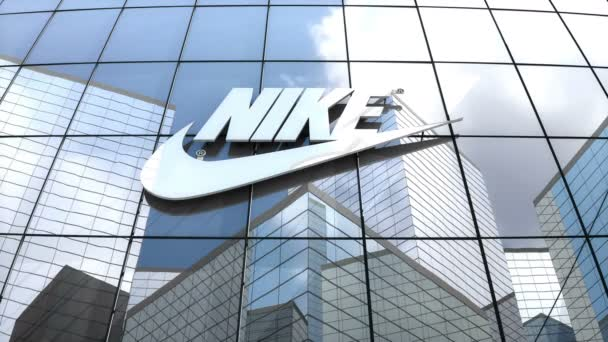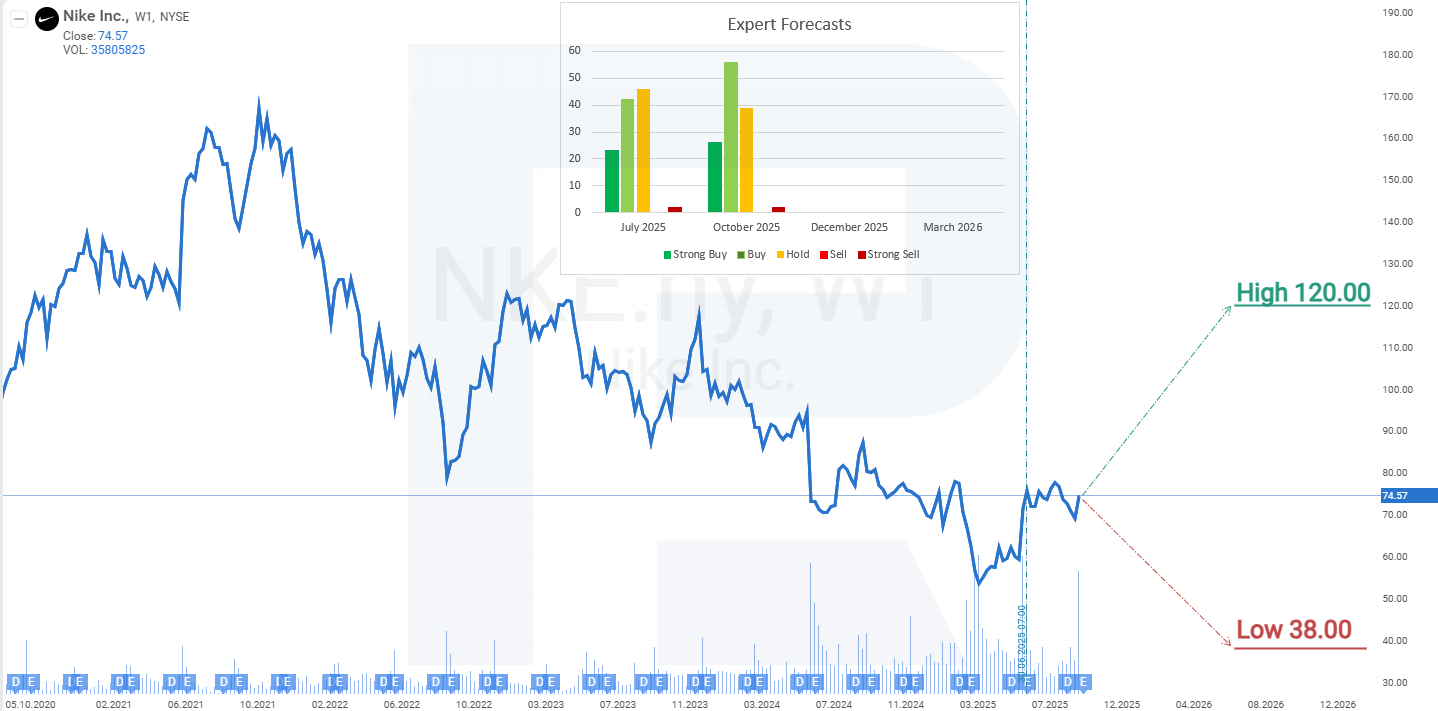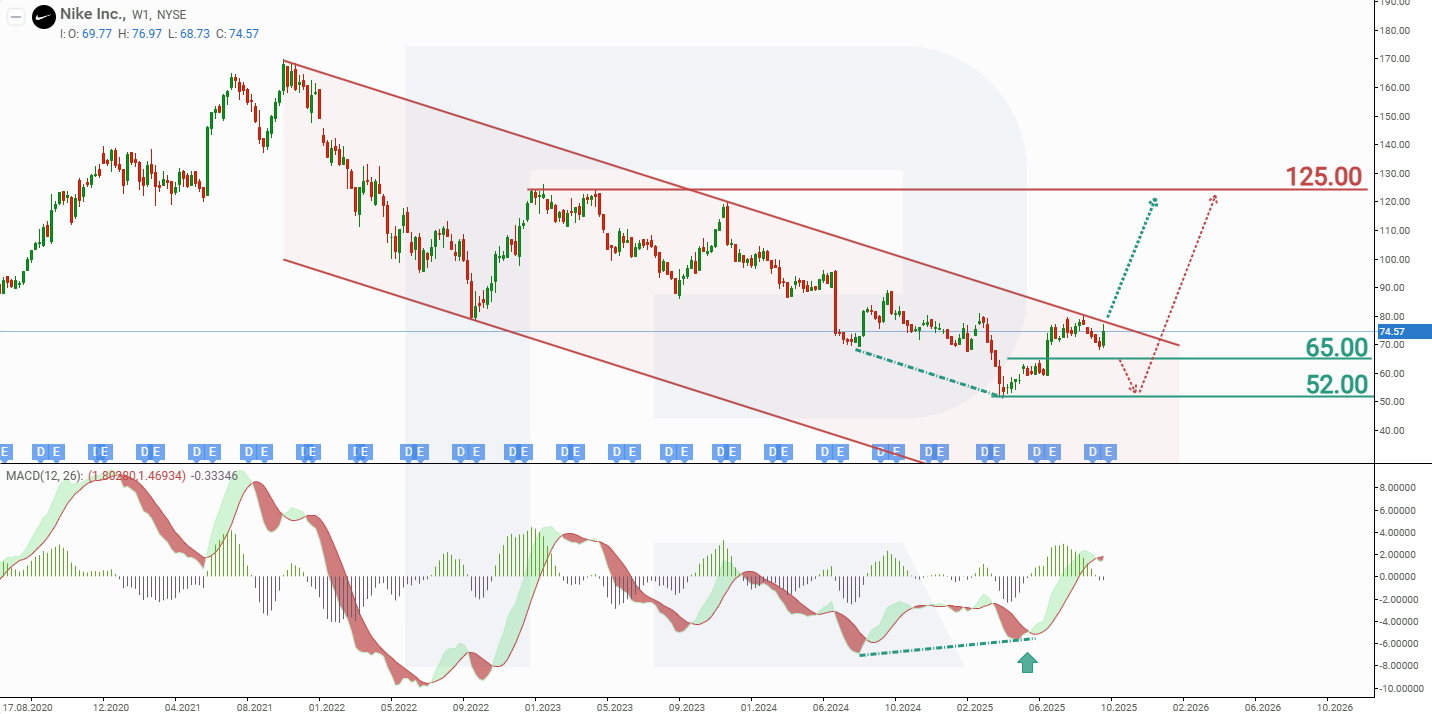Should you buy Nike (NKE) shares in 2025? A review of the Q1 FY2026 results and share price scenarios
Nike has reported better-than-expected results, providing a welcome surprise for investors. Moreover, sales volumes in North America are beginning to recover. Taken together, these factors may signal the start of a positive turnaround in the company’s performance.
Nike, Inc. (NYSE: NKE) released its results for Q1 FY2026, which exceeded analyst expectations. Revenue came in at 11.72 billion USD, up 1% year-on-year and above the forecast of 11.0 billion USD. Earnings per share (EPS) were 0.49 USD, nearly double the expected 0.27 USD. However, gross margin declined to 42.2%, reflecting the impact of discounting, a higher share of wholesale sales, and increased tariff costs.
The main growth driver was wholesale sales, which increased by 7%, particularly in North America. Meanwhile, direct-to-consumer (DTC) sales declined 4%, and digital sales dropped 12%. In China, revenue decreased by 9%, while the Converse brand saw a 27% decline – signalling uneven demand across business segments.
Free cash flow for the quarter totalled just 15 million USD. Despite this, Nike returned approximately 714 million USD to shareholders – 591 million USD through dividends and 123 million USD via share buybacks.
Looking ahead to the next quarter, the company has issued cautious guidance, expecting a slight decline in revenue and a further gross margin contraction of around 3–3.75 percentage points, of which roughly 1.75 points are attributed to new tariffs. Direct-to-consumer sales are not expected to return to growth this fiscal year, with the focus instead on moderate expansion of the wholesale channel.
Investors reacted positively to the results. On the first trading day following the release, Nike shares rose by approximately 6%, as the company exceeded expectations on both revenue and earnings, and showed early signs of recovery in wholesale sales, alongside disciplined cost control. The market viewed the weakness in digital and DTC sales, as well as the tariff impact, as risks already largely priced in.
Further support came from analyst commentary: many noted gradual improvement, and several investment houses raised their ratings and price targets for the stock. Overall, the market appears to be betting that Nike has passed the weakest phase in terms of revenue and inventory, while remaining risks – such as those in China and on margins – persist but are not critical in the short term.
This article examines Nike, Inc., outlines its revenue sources, reviews Nike’s performance over the past three quarters, and sets out expectations for Q2 FY2026. It also provides a technical analysis of NKE shares, forming the basis for a Nike stock forecast for calendar 2025.
About Nike, Inc.
Nike, Inc. is a US-based company founded on 25 January 1964 by Phil Knight and Bill Bowerman under the name Blue Ribbon Sports before rebranding as Nike in 1971. The company designs, manufactures, markets, and sells athletic footwear, apparel, accessories, and equipment. Its primary business segment is athletic footwear, which generates most of its revenue. Nike produces goods for a variety of sports, including running, basketball, football, tennis, golf, and fitness.
The company was listed on the NYSE on 2 December 1980 under the ticker symbol NKE.
Image of the Nike, Inc. company nameNike, Inc.’s main revenue streams
Nike’s revenue is generated from various sources within its business operations, with a primary focus on key areas such as footwear, apparel, and equipment, as well as brand licensing and digital platforms. Nike’s main revenue streams are outlined below:
- Footwear sales : Nike’s largest source of revenue is footwear, including athletic sneakers, casual shoes, and specialised models for running, basketball, and fitness. In Q3 fiscal 2025, footwear remained the dominant category; however, quarterly data show a revenue decline in this segment, highlighting challenges linked to excess inventory and competitive pressures
- Apparel sales : this category encompasses sports and casual apparel, including T-shirts, shorts, tank tops, and outerwear. Apparel complements Nike’s footwear range and is a significant revenue stream, often related to seasonal demand and collaborations with sports companies
- Sports equipment sales : Nike generates revenue from sports equipment, including bags, socks, gloves, and accessories. While smaller than the footwear and apparel segments, this category plays a supporting role in the brand’s ecosystem
- Nike Direct : revenue from direct-to-consumer sales –
including Nike’s website, mobile app, and physical stores –
falls under the Nike Direct segment. This channel prioritises direct sales to consumers, bypassing wholesalers. Digital sales remain a key focus for Nike, with continued investment in e-commerce
Nike, Inc. Q3 FY2025 report
On 20 March, Nike released its earnings report for Q3 of fiscal year 2025, which ended on 28 February. Below are the key financial figures compared to the same period last year:
- Revenue : 11.27 billion USD (-9%)
- Net income : 0.79 billion USD (-32%)
- Earnings per share : 0.54 USD (-30%)
- Gross margin : 41.5% (-330 basis points)
Revenue by country:
- North America : 4.86 billion USD (-4%)
- Europe, Middle East, and Africa : 2.81 billion USD (-10%)
- Greater China : 1.73 billion USD (-17%)
- Asia Pacific and Latin America : 1.47 billion USD (-11%)
The company’s management attributed a 9% decline in revenue to a double-digit drop in sales in January and February, following a successful holiday season in December. China experienced the most significant slump, with sales falling by 17%. Despite growth in the workout and running apparel categories, Nike noted a decline in the sports style and Jordan brand segments, particularly in its classic footwear lines.
Nike’s management forecast a substantial revenue decline of 13.0-15.0% in Q4 of fiscal year 2025, ending on 31 May 2025, which exceeded analysts’ forecasts of 11.4-12.2%. The outlook reflected efforts to liquidate excess inventory and refresh outdated product lines amid external factors such as tariffs and economic uncertainty.
CFO Matthew Friend expected gross margin to decrease by 4-5 percentage points due to the active sell-off of old inventory and the introduction of new, innovative models, noting that Q4 fiscal 2025 would be the period with the most significant impact from these measures, after which pressure on revenue and margins was expected to ease in fiscal 2026.
Overall, Nike’s management described the quarter as a period of progress amid ongoing challenges, exceeding income expectations while continuing to face pressure on revenue and margins. For the upcoming quarter, they forecast a more substantial decline in sales and margins as part of a strategic business relaunch, with hopes for improvements in the fiscal year 2026.
Nike, Inc. Q4 2025 financial report
On 26 June, Nike released its Q4 2025 financial results for the period ending 31 May. Key financial figures compared with the same period last year are as follows:
- Revenue : 11.10 billion USD (-12%)
- Net profit : 0.21 billion USD (-86%)
- Earnings per share : 0.14 USD (-86%)
- Gross margin : 40.3% (-440 basis points)
Revenue by country:
- North America : 4.70 billion USD (-11%)
- Europe, Middle East & Africa : 3.00 billion USD (-9%)
- Greater China : 1.48 billion USD (-21%)
- Asia Pacific & Latin America : 1.58 billion USD (-8%)
Nike’s Q4 2025 report served as an indicator of a transitional phase in the company’s strategy. Despite weak financial results, management demonstrated confidence in the beginning of a recovery cycle. Revenue declined by 12% to 11.1 billion USD, and earnings per share fell by 86% to 0.14 USD. However, both figures exceeded market expectations and were positively received by investors.
Management identified Q4 as the low point in the implementation of the ‘Win Now’ transformation program. Inventory levels continued to decline, the retreat from aggressive discounting was underway, and the product portfolio was being reshaped with a focus on core sports categories. Under the leadership of new CEO Elliott Hill, management took steps to strengthen the brand’s position in key segments and reallocate internal resources.
The market responded to the report with a 14% rise in Nike shares. Analysts at JPMorgan, HSBC, Jefferies, and other investment houses raised their price targets, citing signs of a sustainable business turnaround.
For Q1 2026, Nike projected a mid-single-digit percentage decline in revenue, which represented an improvement on previous market estimates. At the same time, the company anticipated gross margin compression of 350–425 basis points, driven by tariff costs and changes in the sales mix. According to CFO Matt Friend, Nike was prepared to offset up to 1 billion USD in additional tariffs by shifting some production out of China and introducing moderate price increases in the US, starting in autumn.
The restructuring strategy included personnel changes, a refocus on key product lines, optimisation of sales channels, and a return to a more sustainable distributor engagement model. The stabilisation of inventory levels (at approximately 7.5 billion USD) and growing interest in new collections confirmed positive momentum.
Despite continued revenue pressure in several regions (notably a 11% decline in North America and a 21% decline in China), the company was laying the groundwork for a gradual recovery in operational efficiency. With external risks easing and the planned initiatives being successfully implemented, Nike’s medium-term share price outlook was assessed as positive.
Nike, Inc. Q1 FY2026 report
On 30 September, Nike released its financial results for Q1 FY2026, covering the period ended on 31 August. The key financial indicators, compared with the same period of the previous year, are as follows:
- Revenue : 11.72 billion USD (+1%)
- Net profit : 0.72 billion USD (–31%)
- Earnings per share (EPS) : 0.49 USD (–30%)
- Gross margin : 42.2% (–320 basis points)
Revenue by region:
- North America : 5.02 billion USD (+4%)
- Europe, Middle East & Africa : 3.33 billion USD (+6%)
- Greater China : 1.51 billion USD (–9%)
- Asia Pacific & Latin America : 1.49 billion USD (+2%)
Nike’s quarterly report exceeded analyst expectations. Revenue totalled 11.72 billion USD, up 1% year-on-year and well above the expert forecast of 11.0 billion USD. Adjusted EPS came in at 0.49 USD, nearly double the expected 0.27 USD.
The stronger performance was driven primarily by wholesale sales growth and recovering demand in North America. Products in the running, training, and basketball categories performed particularly well. However, NIKE Direct sales fell 4% year-on-year, while digital channel sales dropped 12%. In China, demand remained weak, with no signs of improvement so far. Gross margin also declined to 42.2%, down 3.2 percentage points from the previous year, due to higher discounting, changes in channel mix, and rising costs, including customs tariffs. As a result, profitability declined, despite the strong figures for revenue and earnings per share.
For the upcoming quarter, Nike issued cautious guidance. The company expects revenue to fall by a few percentage points and gross margin to contract further by 3.0–3.75 percentage points, partly due to tariffs. Operating expenses (SG&A) in absolute terms are expected to continue rising, while the effective tax rate will be slightly above 20%. According to management, direct sales through Nike’s own channels are not expected to return to growth over the course of FY2026.
Fundamental analysis of Nike, Inc.
Below is the fundamental analysis of NKE following the Q1 FY2026 results:
- Liquidity and debt : as of 31 August 2025, Nike’s current assets totalled 23.90 billion USD, compared with current liabilities of 10.91 billion USD, resulting in a current ratio of approximately 2.19x. Cash and short-term investments amounted to 8.58 billion USD, while total debt stood at 7.996 billion USD with no short-term borrowings. The company’s net cash position was approximately 0.58 billion USD. The decline in cash holdings over the past year reflects dividend payments, share buybacks, bond repayments, and capital expenditure, yet overall liquidity remains solid
- Cash flow : free cash flow (FCF) for the quarter was approximately 15 million USD (operating cash flow of 222 million USD minus CapEx of 207 million USD). Although positive, this figure was well below total shareholder distributions – Nike paid 591 million USD in dividends and conducted share buybacks worth 126 million USD in Q1. The 18 billion USD buyback program remains active, with 12.1 billion USD of shares repurchased since 2022
Nike has funded dividends and buybacks primarily through operating cash flow and its cash reserves, without resorting to additional borrowing for this purpose.
- Profitability and earnings quality : revenue of 11.7 billion USD and EPS of 0.49 USD both exceeded analyst expectations, but gross margin fell 3.2 percentage points to 42.2%, driven by increased discounting, a higher share of wholesale sales, and tariff pressure in the US. SG&A expenses declined 1%, partially offsetting this margin compression. Wholesale sales rose 7% (notably in North America, in the running, training, and basketball categories), while NIKE Direct fell 4% and digital sales dropped 12%. Demand in China remains weak, and Converse revenue fell 27%. From an earnings quality perspective, the results appear mixed: although EPS exceeded expectations, this came against a backdrop of lower margins and uneven demand across segments. In other words, the profit increase does not yet signal a strong, sustainable trend – Nike still needs to prove it can consistently improve performance going forward
- Financial stability : inventories declined to 8.11 billion USD (–2% year-on-year), reflecting progress in clearing older collections. Leverage remains moderate, with shareholders’ equity of 13.47 billion USD. Lease liabilities are manageable, with no significant debt repayments falling due in the near term. The balance sheet allows the company to continue investing in products, marketing, and shareholder returns, even amid fluctuating demand. However, tariff-related cost pressures remain a persistent drag on profitability
Conclusion of the fundamental analysis of NKE:
Nike’s financial position remains sound, with strong liquidity, a near-zero net debt position, and tight cost control underpinning its business model. However, earnings quality remains under pressure: gross margin has narrowed, direct and digital sales are weakening, and the Chinese market continues to show softness. The outlook for the coming months remains cautious – management expects revenue to decline and margins to compress further in Q2, with tariffs accounting for a significant portion of the pressure.
In the medium term, Nike’s focus lies on wholesale expansion, product refreshes, and major sporting events. If margins recover and China stabilises, free cash flow and shareholder returns could improve. In the short term, however, risks remain tied to earnings pressure and exposure to rising costs.
Expert forecasts for Nike, Inc. stock
- Barchart : 16 of 36 analysts rated Nike shares as a Strong Buy, 4 as a Moderate Buy, 14 as Hold, and 2 as a Strong Sell. The top-end forecast stands at 120 USD, with the lower-end forecast at 38 USD
- MarketBeat : 27 of 34 analysts assigned a Buy rating, and 7 recommended Hold. The top-end forecast is 115 USD, with the lower-end forecast at 58 USD
- TipRanks : 18 of 28 analysts rated the stock as Buy, and 10 as Hold. The top-end forecast is 120 USD, with the lower-end forecast at 60 USD
- Stock Analysis : 10 of 25 experts rated Nike shares as a Strong Buy, 7 as Buy, and 8 as Hold. The top-end forecast is 115 USD, with the lower-end forecast at 60 USD
Nike, Inc. stock price forecast for 2025
On the weekly chart, Nike shares have been trading within a downward channel since November 2021. Following the release of the Q4 FY2025 report, which exceeded analyst expectations, the stock rose by around 30% and tested the descending trend line acting as resistance. However, for a decisive breakout from the downtrend, investors required clearer confirmation of a sustained recovery in Nike’s fundamentals. As a result, many opted to lock in profits and wait for the next quarterly report. The Q1 FY2026 results once again surpassed market expectations, driving renewed demand for the stock and bringing NKE shares back close to the descending trendline. Based on the current performance of Nike shares, the two possible outcomes for 2025 are as follows:
- Base case forecast for Nike shares : this assumes a breakout above the trend line, followed by an advance towards resistance at 125 USD. Such a move could be supported by improving financial performance, the ongoing share buyback program, and the company’s stable dividend policy. Together, these factors may strengthen investor interest and help the stock reach its target price.
- Alternative outlook for Nike stock : this assumes a break below support at 65 USD. In this case, the share price could decline towards the next key support of around 52 USD. From this level, a recovery in Nike’s share price may occur if the company demonstrates a sustained improvement in its financial results.
Risks of investing in Nike, Inc. stock
When investing in Nike, it is crucial to consider the risks that may negatively impact the company’s income and affect its investors. The main risks are outlined below:
- The impact of tariffs on profit margins : Nike has warned that higher tariffs on imports from China and Mexico could significantly reduce profit margins
- Competition and loss of market share : Nike faces intense competition from brands such as New Balance and Adidas, which are strengthening their positions, particularly in casual footwear and retro model segments. This poses a threat to Nike’s market share
- Economic instability : factors such as inflation, recession fears, and reduced purchasing power may lead to decreased consumer spending on sportswear and footwear, ultimately impacting Nike’s revenues
Forecasts presented in this section only reflect the author’s private opinion and should not be considered as guidance for trading. RoboForex bears no responsibility for trading results based on trading recommendations described in these analytical reviews.




